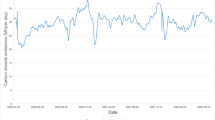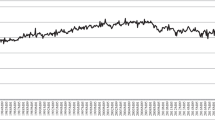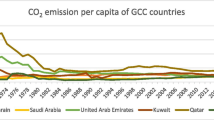Abstract
Climate change poses significant challenges globally, demanding accurate forecasting methodologies to comprehend and address its consequences. This paper presents a comparative analysis of hybrid models for forecasting carbon dioxide (\(CO_2\)) emissions in drought-prone Somalia. The study employs 15 time series models, including six single time series models AutoRegressive Integrated Moving Average (ARIMA), Error Trend Seasonality (ETS), Trigonometric seasonality, Box-Cox transformation (TBATS), AutoRegressive Fractionally Integrated Moving Average (ARFIMA), and Neural Network AutoRegression (NNAR) and nine hybrid models (ARIMA-ETS, ARIMA-TBATS, ARIMA-Theta, ARIMA-NNAR, ARIMA-ETS-TBATS, ARIMA-NNAR-Theta, ARIMA-NNAR-TBATS, ARIMA-ETS-Theta, and ARIMA-ETS-NNAR). The dataset spans from 1950 to 2020, with a training set from 1950 to 2010 and a testing/validation set from 2011 to 2020. The models are evaluated using various metrics, including Mean Absolute Scaled Error (MASE), Symmetric Mean Absolute Percentage Error (SMAPE), Mean Absolute Percentage Error (MAPE), and Theil’s U statistic. The data are found to be non-stationary, requiring the application of differencing techniques. Among the single time series models, TBATS(0.717, 0,0, 1, -) performs the best, while the ARIMA-TBATS hybrid model outperforms the other hybrid models. The forecasts provide valuable insights for addressing the challenges posed by charcoal burning and exporting in Somalia. The study concludes with recommendations for future research, including the incorporation of socio-economic and policy variables, spatial analysis, and long-term forecasting.






Similar content being viewed by others
Explore related subjects
Discover the latest articles and news from researchers in related subjects, suggested using machine learning.Data Availability
The data that support the findings of this study are available on request from the corresponding author.
Abbreviations
- ADF:
-
Augmented Dickey-Fuller
- AIC:
-
Akaike Information Criterion
- ARFIMA:
-
Autoregressive Fractionally Integrated Moving Average
- ARIMA:
-
Autoregressive Integrated Moving Average
- ETS:
-
Error Trend Seasonality
- MASE:
-
Mean Absolute Scaled Error
- MAPE:
-
Mean Absolute Percentage Error
- NNAR:
-
Neural Network Autoregression
- PP:
-
Phillips-Perron
- SMAPE:
-
Symmetric Mean Absolute Percentage Error
- TBATS:
-
Trigonometric Seasonal Decomposition of Time Series
References
Ali Warsame A, Hassan Abdi A (2023) Towards sustainable crop production in Somalia: Examining the role of environmental pollution and degradation. Cogent Food Agric 9(1):2161776
Ansah PK (2022) The impact of charcoal production on the forest of Sub-Saharan Africa: A theoretical investigation. J Sustain Dev 15(2)
Azad AS, Sokkalingam R, Daud H, Adhikary SK, Khurshid H, Mazlan SNA, Rabbani MBA (2022) Water level prediction through hybrid SARIMA and ANN models based on time series analysis: Red hills reservoir case study. Sustainability 14(3):1843
Belbute JM, Pereira AM (2015) An alternative reference scenario for global co2 emissions from fuel consumption: An ARFIMA approach. Econ Lett 136:108–111
Bolognesi M, Vrieling A, Rembold F, Gadain H (2015) Rapid mapping and impact estimation of illegal charcoal production in Southern Somalia based on worldview-1 imagery. Energy Sustain Dev 25:40–49
De Livera AM, Hyndman RJ, Snyder RD (2011) Forecasting time series with complex seasonal patterns using exponential smoothing. J Am Stat Assoc 106(496):1513–1527
Faruque MO, Rabby MAJ, Hossain MA, Islam MR, Rashid MMU, Muyeen S (2022) A comparative analysis to forecast carbon dioxide emissions. Energy Rep 8:8046–8060
Gunasekera UC, Sivasothy A, Wedasingha N, Thayaparan S, Rotewewa B, Muralithas M, Baumann MP, Punyapornwithaya V (2017) Analyzing the foot and mouth disease outbreak as from 2008 to 2014 in cattle and buffaloes in Sri Lanka. Prev Vet Med 148:78–88
Hyndman RJ, Athanasopoulos G (2018) Forecasting: principles and practice. OTexts
Hyndman RJ, Koehler AB (2006) Another look at measures of forecast accuracy. Int J Forecast 22(4):679–688
Karabiber OA, Xydis G (2019) Electricity price forecasting in the Danish day-ahead market using the TBATS, ANN and ARIMA methods. Energies 12(5):928
Kumari S, Singh SK (2022) Machine learning-based time series models for effective co2 emission prediction in India. Environ Sci Pollut Res 1–16
Li S, Li R (2017) Comparison of forecasting energy consumption in Shandong, China using the ARIMA model, GM model, and ARIMA-GM model. Sustainability 9(7):1181
Lin C-C, He R-X, Liu W-Y (2018) Considering multiple factors to forecast co2 emissions: A hybrid multivariable grey forecasting and genetic programming approach. Energies 11(12):3432
Oduori S, Rembold F, Abdulle O, Vargas R (2011) Assessment of charcoal driven deforestation rates in a fragile rangeland environment in North Eastern Somalia using very high resolution imagery. J Arid Environ 75(11):1173–1181
Panja M, Chakraborty T, Kumar U, Liu N (2023) Epicasting: An ensemble wavelet neural network for forecasting epidemics. Neural Netw
Perone G (2021) Comparison of ARIMA, ETS, NNAR, TBATS and hybrid models to forecast the second wave of covid-19 hospitalizations in Italy. Eur J Health Econ 1–24
Punyapornwithaya V, Mishra P, Sansamur C, Pfeiffer D, Arjkumpa O, Prakotcheo R, Damrongwatanapokin T, Jampachaisri K (2022) Time-series analysis for the number of foot and mouth disease outbreak episodes in cattle farms in Thailand using data from 2010–2020. Viruses 14(7):1367
Qader MR, Khan S, Kamal M, Usman M, Haseeb M (2021) Forecasting carbon emissions due to electricity power generation in Bahrain. Environ Sci Pollut Res 1–12
Rembold F, Oduori S, Gadain H, Toselli P (2013) Mapping charcoal driven forest degradation during the main period of Al Shabaab control in Southern Somalia. Energy Sustain Dev 17(5):510-514
Shaub D (2020) Fast and accurate yearly time series forecasting with forecast combinations. Int J Forecast 36(1):116–120
Sun Z (2020) Comparison of trend forecast using ARIMA and ETS models for S &P500 close price. In: Proceedings of the 2020 4th international conference on E-Business and Internet. pp 57–60
Terefe B, Asefa W (2022) Woreda level participatory land use planning (WLPLUP) approaches in pastoral and agro pastoral areas of Ethiopia
Tudor C (2016) Predicting the evolution of co2 emissions in Bahrain with automated forecasting methods. Sustainability 8(9):923
Wanyoike F, Rich KM, Mtimet N, Bahta S, Godiah L (2023) An assessment of small ruminant production, marketing, and investment options in Somaliland: A system dynamics approach. Small Rumin Res 218:106882
Warsame AA, Abdi AH, Amir AY, Azman-Saini W (2023) Towards sustainable environment in Somalia: The role of conflicts, urbanization, and globalization on environmental degradation and emissions. Journal of Cleaner Production 406:136856
Yang H, O’Connell JF (2020) Short-term carbon emissions forecast for aviation industry in Shanghai. J Clean Prod 275:122734
Yusof F, Kane I (2012) Modelling monthly rainfall time series using ETS state space and SARIMA models. Int J Curr Res 4(9):195–200
Funding
This research received no external funding.
Author information
Authors and Affiliations
Contributions
O.M.E., C.C. and A.H.M. conceived the research topic, explored that idea, performed the analysis and drafted the manuscript.
Corresponding author
Ethics declarations
Conflict of interest
The authors declare no conflict of interest.
Additional information
Communicated by: H. Babaie.
Publisher's Note
Springer Nature remains neutral with regard to jurisdictional claims in published maps and institutional affiliations.
Rights and permissions
Springer Nature or its licensor (e.g. a society or other partner) holds exclusive rights to this article under a publishing agreement with the author(s) or other rightsholder(s); author self-archiving of the accepted manuscript version of this article is solely governed by the terms of such publishing agreement and applicable law.
About this article
Cite this article
Egeh, O.M., Chesneau, C. & Muse, A.H. Exploring hybrid models for forecasting \(CO_2\) emissions in drought-prone Somalia: a comparative analysis. Earth Sci Inform 16, 3895–3912 (2023). https://doi.org/10.1007/s12145-023-01126-0
Received:
Accepted:
Published:
Issue Date:
DOI: https://doi.org/10.1007/s12145-023-01126-0




